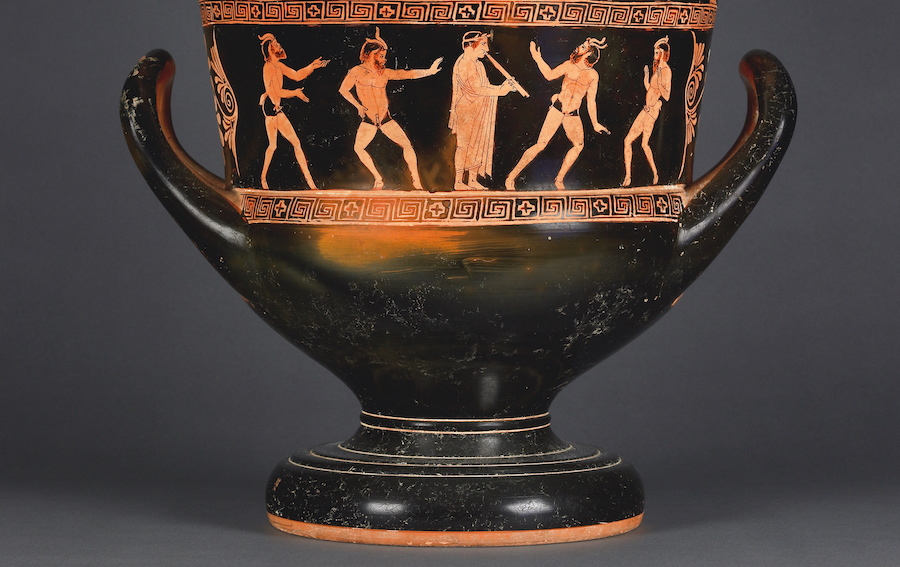'Goat-song' analysis examines origins of mythical satyrs in culture and drama

LAWRENCE — The vulgar woodland spirits known as satyrs remain popular in modern works such as “The Lion, the Witch and the Wardrobe,” “Percy Jackson & the Olympians” and Disney’s “Hercules.” But the depiction and purpose of these ancient Greek creations have evolved considerably over the centuries.
 “People have used the figure of satyrs to try to cement the origins of drama in Greek religion and to associate drama with an idea of primitive ritual performed by rugged humans close to nature,” said Paul Touyz, assistant professor of classics at the University of Kansas.
“People have used the figure of satyrs to try to cement the origins of drama in Greek religion and to associate drama with an idea of primitive ritual performed by rugged humans close to nature,” said Paul Touyz, assistant professor of classics at the University of Kansas.
“They give thought-provoking insight into the way historic origins are reinvented over time and how they’re reinvented to speak to contemporary interests and concerns,” he said.
Touyz's new chapter titled “Putting the ‘Goat’ Into ‘Goat-song’: The Conceptualization of Satyrs on Stage and in Scholarship” appears in the edited volume “Reconstructing Satyr Drama” (De Gruyter, 2021).
As Touyz (pronounced Tao-ez) noted, satyrs occupy a privileged position in ancient and modern accounts of the foundation of tragedy. In classical Athens, they encompassed the chorus in a genre knows as “satyr play,” which parodied tragedy and was distinguished by its bawdy humor.
The professor said he believed his article would help readers appreciate the origin of tragedy, which is more broadly the dramatic basis of Western theater, TV and film.
He said, “If you look at the issue of the origins of drama more as a story being told repeatedly by different generations that tried to understand the strange practice of pretending to be somebody else in front of a large group of people, you can see how it’s evolving over time and how it fits into different religious as well as political contexts.”
Satyrs themselves have also evolved. In ancient Greece, they were represented as a human with horse ears and tail. In Rome, they developed into having goat’s ears, legs, horns and tail.
“If you search for satyrs on Wikipedia, you’ll be told they’re half-goat, half-man creatures. In reality, their shapes and nature changes depending on the artistic image you look at or the various works of literature you might read,” he said. “They’re more like a general nature spirit that combines elements of the animalistic as well as human.”
Yet it’s how satyrs relate to tragedy that interests Touyz.
“The subject of tragedy is never just about the history of drama, the books we read or movies we watch. The words tragedy and comedy have a lot more purchase. Satyrs, for example, have been used to explain the nature and origins of comedy and especially satire,” he said.
The titular “goat-song” is one way of understanding what Greek tragedy represents.
“Goat-song was once thought to be sung by a group of people dressed up as goats, aka satyrs,” he said. “That’s probably not the case. Scholars of the Greek language have convinced most people that ‘goat-song’ really means the song you sing in order to win a goat or in order to find a goat to sacrifice to the gods.”
Historically, people have thought of the satyr play as a very specific art form tied to the Golden Age origins of drama that eventually ceased to be relevant when tragedy became the dominant genre. But there are concrete references from the Byzantine Empire to individuals who still wear satyr masks in the streets.
“You can imagine people in Asia Minor remembering ‘the old ways’ and clinging to such customs,” he said. “They still have these sayings and folk tales in modern Greece — and even Turkey — that capture the continuous condition and memory of the satyr.”
A native of Sydney, Australia, Touyz has been at KU since 2017. His area of expertise is Greek literature, language and history. (“If there is a Greek author I can sit back with my feet in front of the fire reading, that would be Plato,” he said.)
Touyz plans to spend the next few years finishing a book that will track the institutional history of satyr play as a genre and its place in the broader cultural sphere.
“I’d like to get people thinking about the way in which all the scholarship and enormous cultural energy dedicated to the origins of tragedy can be read as different interpretations that speak to the perspectives and concerns of different times,” he said.
“What we can do with these materials is tell an interesting story about the way our relationship to this genre — and this general issue of what it is for something to be tragic — has changed and evolved over time.”
Top photo: Satyrs are depicted in a red-figure calyx krater (known as the “Pandora krater”), attributed to the Niobid Painter (c. 460-450 B.C.).